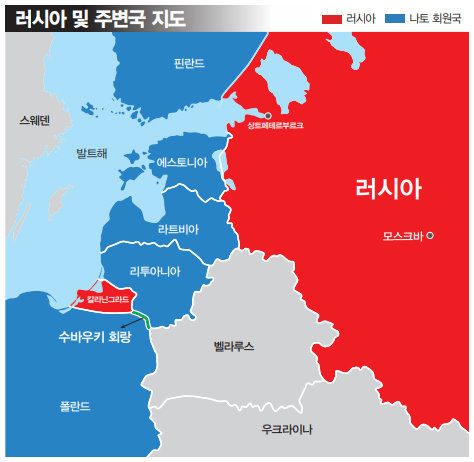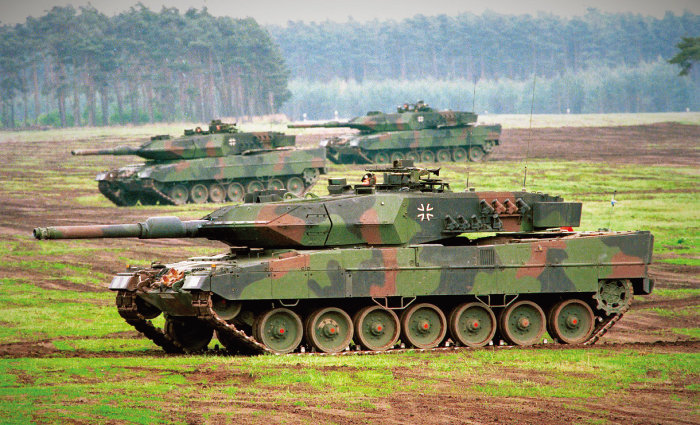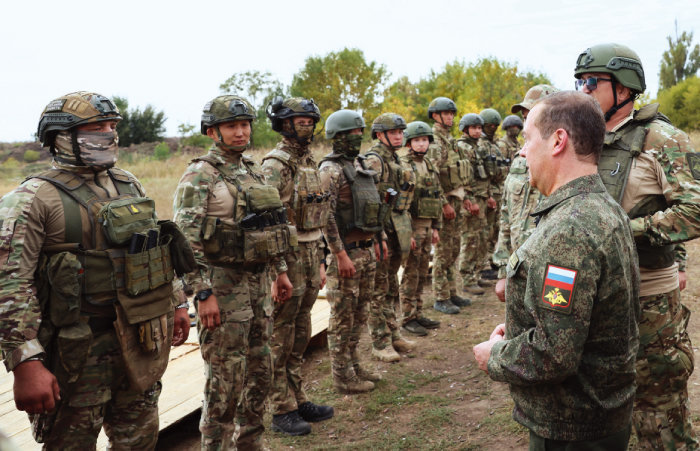Germany’s Bild magazine reports on obtaining classified documents from the Ministry of Defense on ‘preparations for Russian invasion of Europe’
With Ukraine and the Middle East becoming a battlefield, foreign affairs and security experts from major countries around the world select East Asia as the most likely place where the next war will break out. Actually, this observation is not new. High-ranking figures, such as the director of the U.S. Central Intelligence Agency (CIA), the commander of the Indo-Pacific Command, and the commander of the Air Transport Command, have already warned that there is a high possibility that the United States and China will clash militarily over the Taiwan issue between 2025 and 2027. Concerns about a conflict between the two countries are increasing as China pursues hegemony, so not many people are surprised by the possibility of a US-China war. However, recently, alarm bells have been ringing that there is a high possibility of a large-scale war breaking out in Europe as well.
On January 15 (local time), the German tabloid Bild obtained confidential documents from the German Ministry of Defense and reported, “The German military is preparing for Putin’s attack.” The gist of this report is that the German Ministry of Defense is concerned that Russia may invade a NATO (North Atlantic Treaty Organization) member state as early as this year and is seeking countermeasures. The scenario for the Russian invasion of Europe predicted by the German military is as follows. After ending the war with Ukraine in some way by June, they will use the Russian residents of the three Baltic countries, including Estonia, Latvia, and Lithuania, to cause a war of division. Estonia (28.1%), Latvia (37.8%), and Lithuania (8%) are countries that simultaneously joined NATO and the European Union (EU) and have a significant proportion of Russian residents. It is suspected that Russia is trying to use Russian residents in the Baltic countries to start a civil war like the Donbas War in 2014 and then deploy military force in the name of ‘protecting compatriots’. President Vladimir Putin’s recent statement that “the Baltic countries are persecuting Russian residents, which is posing a serious problem to Russian national security” appears to be an attempt to heighten the atmosphere of war.
An internal German military document reported by Bild also raised the possibility that in case of emergency, Russia would attack not only the Baltic countries but also the ‘Suwauki Corridor’ along the Lithuanian-Polish border via Belarus to connect with Kaliningrad, a Russian territory. It also included an analysis that the situation was not favorable even though NATO responded by mobilizing 300,000 troops, including 30,000 German soldiers. Russia currently has tactical nuclear weapons deployed in Kaliningrad. If Russia fiddles with tactical nuclear weapons and puts pressure on it, NATO has no response whatsoever. From the perspective of Western European countries, they cannot accept the threat of a nuclear attack on London, Paris, and Berlin in order to recover the Baltic countries and the Suwauki Corridor, which are on the outskirts.
 state | Sweden applies for NATO membership GettyImages
state | Sweden applies for NATO membership GettyImagesSince last year, European countries have been closely watching the possibility of a Russian invasion. Last December, Poland’s National Intelligence Service and the Ministry of Foreign Affairs warned, “We must prepare for the possibility that Russia will invade a NATO member country within 36 months.” Around the same time, the German Minister of Defense, the Chiefs of Defense Staff of the Dutch and Belgian Armed Forces, and the Prime Minister of Estonia also warned of the possibility of Russia provoking war. This year, the Swedish Minister of Civil Defense even said, “I can’t sleep at night worrying that a war with Russia could break out in the near future and that we are not prepared for it.” Why did top officials from various European countries suddenly publicly warn of the possibility of war, saying that a Russian invasion was approaching? To understand this situation, we need to look at what has happened in Europe in recent years.
Europe is already at virtual war with Russia. European countries are imposing strong sanctions on Russia, which invaded Ukraine. If you look at NATO’s various supports for Ukraine, they did not just clash guns and swords with the Russian military. In addition to providing weapons, ammunition, and various supplies, we also provide education and training and equipment repair for the Ukrainian military. Military cooperation is at a significant level, with NATO early warning aircraft and reconnaissance aircraft providing real-time reconnaissance information to Ukraine. This is virtually the same as NATO participating in the war. Russia confirmed NATO’s hostility towards the country after the invasion of Ukraine, but since it could not open a new front, it only protested verbally.
Russia has been at war for the past two years, transitioning to a wartime economic system and trying to restore its military power from the former Soviet Union. In addition to deploying new nuclear weapons one after another, it also withdrew from the Conventional Arms Reduction Treaty in Europe (CFE) last year and declared its intention to increase its military. Additionally, thanks to help from China and North Korea, Russia began mass producing conventional weapons at the end of last year. As a result, Ukraine, which was advocating a ‘great offensive’ until last summer, is now completely on the defensive and fighting a difficult defensive battle.
Although Russia has begun to increase its nuclear and conventional armaments, NATO member countries are poorly prepared. After the end of the Cold War, the military power of each European country declined to the point where it was no longer possible to wage an all-out war. The regular armies of Britain, France, and Germany, the great powers, number only around 200,000 each, including the land, sea, and air forces. These three countries only have about 700 tanks, and even these are operating at rock-bottom levels. In 2022, Germany sent an elite armored vehicle unit to NATO joint exercises, but not a single armored vehicle in this unit was in working order. Last year, a report was published in the British Parliament showing that only about 40 of the 220 tanks owned by the British Army were actually operational, causing a stir. The problems caused by this lack of military power are already becoming a reality. Initially, Germany decided to deploy one of its own mechanized brigades to Lithuania, which faces a security threat from Russia. However, the German army could not afford to form a brigade on its own, so it belatedly decided to receive support from NATO troops. Since the German military, which once claimed to be the core force of NATO forces, is in this state, there are concerns about how serious the collapse of the military capabilities of many member countries will be.
 German Leopard 2 tank. Wikipedia
German Leopard 2 tank. WikipediaThe bigger problem is the shaky U.S. security posture. After the inauguration of the Joe Biden administration, not only US military power, but also alliances and solidarity were greatly weakened. Unlike Russia, U.S. nuclear power has been on a downward trend amid the post-Cold War trend, and major weapons development and introduction projects have been canceled or postponed, leading to a significant weakening of conventional military power. For example, the aircraft carrier, a symbol of U.S. military power, is showing the worst utilization rate due to delays in construction for maintenance and modernization. While an average of 2 to 3 surface combatants have been commissioned each year over the past three years, about 30 ships, including Aegis cruisers, have been retired or are scheduled to be retired early. At a time when the Air Force was also complaining about a shortage of fighter jets, the Biden administration announced that it would retire 32 F-22s, said to be the world’s strongest, and 131 first-class fighter jets early, resulting in a conflict with Congress.
Now that the military power of the United States and NATO has been greatly weakened and the solidarity of Western countries has loosened, this would be a golden opportunity for Russia to avenge the humiliation it suffered in the war with Ukraine. At the same time, it is an excellent opportunity to achieve the strategic goals that Russia has pursued for a long time. Russia’s strategic goals are to obtain an ice-free port that does not freeze even in winter and to secure a buffer zone in the European Plain. The purpose of most of Russia’s wars during the imperial era was to secure floating ports, so stable maritime advancement was an important issue for them. However, Russia’s key port, Baltic Sea St. Petersburg, along with Sevastopol on the Black Sea and Vladivostok on the Pacific, have recently been threatened. Finland has joined NATO, Sweden has also applied for membership, and as Poland and the Baltic countries are strengthening their military capabilities, there is a possibility that St. Petersburg, Russia’s largest trading port, may be blocked at any time. From Russia’s perspective, it must secure a buffer zone in the Baltic countries and Scandinavia and secure control over the Baltic Sea.
The European Great Plain is a wide land buffer zone that Russia desperately needs. In the past, the armies of Napoleon and Hitler broke through the Great Plains of Europe and threatened Moscow. ‘European Russia’, including Moscow, where population and economic power are concentrated, is protected by the natural barrier of the Ural Mountains to the east and the Black Sea, a natural moat to the south. On the other hand, there are no significant natural obstacles in the Great Plains of Europe, which stretches from Germany-Poland-Belarus. The fact that the Baltic countries, including Latvia, which is an eight-hour drive from Moscow, became NATO members is bound to be a thorn in Russia’s eyes. In President Putin’s eyes, the invasion of the Baltic countries will be seen as a trick to kill two birds with one stone: defending Moscow and securing control of the Baltic Sea.
 Deputy Chairman of the Russian National Security Council Dmitry Medvedev (right) is talking with military personnel in the Russian-occupied Donetsk region of Ukraine on September 15 last year (local time). Russia established an unrecognized state in this region called the ‘Donetsk People’s Republic’ with Russian residents at the forefront. Newsis
Deputy Chairman of the Russian National Security Council Dmitry Medvedev (right) is talking with military personnel in the Russian-occupied Donetsk region of Ukraine on September 15 last year (local time). Russia established an unrecognized state in this region called the ‘Donetsk People’s Republic’ with Russian residents at the forefront. NewsisAt first glance, Russia’s invasion of the Baltic countries, which could become a reality in the near future, seems like a story from a distant country. However, Russia’s attempt to change the status quo in Europe could eventually lead to a crisis on the Korean Peninsula. If Russia starts a war in Europe, the United States and NATO will not have the capacity to take care of security in other regions. For China and North Korea, this may be the optimal time to launch high-intensity military provocations against Taiwan and South Korea, respectively. In a speech on January 15 (local time), British Defense Secretary Grant Shacks predicted that armed conflicts would increase further around the world, saying, “Within five years, we will see Russia, Iran, China, and North Korea on various battlefields.” His appeal was for Britain and its allies and friends to increase military investment and prepare for security contingencies. As such, countries around the world are strengthening their security posture, such as significantly increasing their defense budget or reintroducing the conscription system. It is time to reflect on whether the Republic of Korea is responding appropriately to the rapidly changing global security landscape.
[이 기사는
주간동아 1425호
에 실렸습니다]
Shin In-gyun, CEO of Independent Defense Network
Source: Donga
Mark Jones is a world traveler and journalist for News Rebeat. With a curious mind and a love of adventure, Mark brings a unique perspective to the latest global events and provides in-depth and thought-provoking coverage of the world at large.